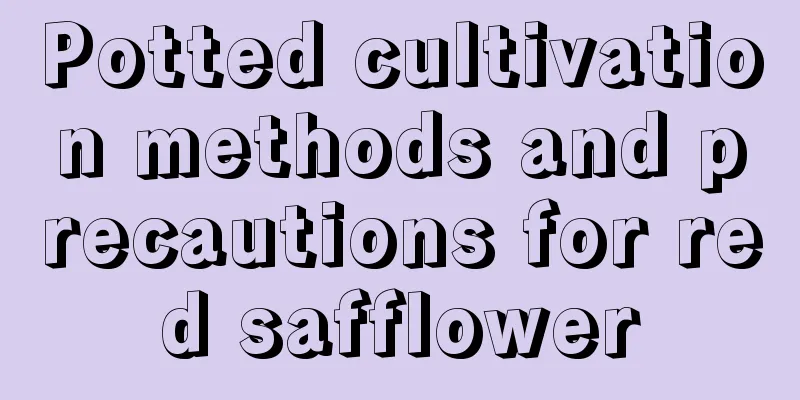Maintenance methods of Kalanchoe in summer

|
Kalanchoe is a very common home potted green plant. It has a relatively short plant and is more suitable for maintenance on the balcony. It has various colors and clusters of flowers, which are very beautiful. Many people like to grow it. In summer, Kalanchoe will enter a dormant or semi-dormant state and stop growing. Here’s how to care for Kalanchoe in summer. 1. Avoid strong light We know that Kalanchoe likes warm environment and light. In spring, autumn and winter, it can be maintained in an environment with plenty of sunlight. However, it is not heat-resistant and is afraid of high temperatures in summer. As long as the temperature exceeds 30℃, do not expose it to direct sunlight and be sure to avoid strong light. Otherwise, the Kalanchoe will be sunburned or even killed. Choose a cool environment, or spend the summer in an air-conditioned room during high temperatures, and pay attention to ventilation in the morning and evening. 2. Avoid rain In summer, Kalanchoe is not only afraid of heat and sun, but also particularly afraid of rain. When growing Kalanchoe outdoors, be sure to move it to a cool, rain-proof environment in a timely manner to prevent it from getting wet in the rain, especially during the rainy season when temperatures are high and humidity is high. If it gets wet in the rain, it can easily cause the branches and leaves of the Kalanchoe to rot or the roots to rot due to waterlogging. The Kalanchoe is not suitable for outdoor maintenance under high temperature conditions. The alternating cold and heat, high temperature and high humidity caused by the rain are like "adding insult to injury" for the Kalanchoe. 3. Control the temperature Knowing that Kalanchoe is afraid of heat, many flower lovers will move it indoors for maintenance. However, changing the environment simply to avoid strong light may not solve the problem of the Kalanchoe surviving the summer smoothly. Because even indoors, if the indoor temperature exceeds 30℃, it still can't stand it. The higher the outdoor temperature, the higher the indoor temperature. Therefore, it is necessary to control the ambient temperature. You can spend the summer in an air-conditioned room and keep the temperature below 30℃. 4. Control moisture Kalanchoe is a succulent plant belonging to the Crassulaceae family. As we all know, succulents are relatively drought-resistant and basically don’t like water. During daily maintenance, be sure to water less. However, summer is coming, and some flower lovers may think that the Kalanchoe will like more water when the weather is hot. So, I watered the plants as much as I could, but the roots ended up rotting. Kalanchoe usually enters a dormant state in the summer, especially when the temperature is above 35℃, it basically stops growing. Therefore, at this time, you must control the moisture and try to water as little as possible. 5. Control fertilization The reason is similar to that of controlling water. When Kalanchoe enters summer, due to the high temperature, it is basically in a dormant or semi-dormant state. At this time, it does not require much water, so try to control the water as much as possible. In particular, there is basically no requirement for fertilizer . During the high temperatures in summer, we should stop fertilizing. Otherwise, it will be counterproductive. Because it cannot be absorbed at all, it will cause fertilizer damage and cause the death of the Kalanchoe. 6. Pay attention to ventilation Most people prefer to place Kalanchoe indoors for maintenance. But when summer comes, for some unknown reason, it suddenly becomes listless and the whole plant looks sickly. In fact, this situation is mostly caused by poor indoor ventilation. Due to the high temperature, the indoor temperature is stuffy and there is no ventilation, and the Kalanchoe can't stand it for a long time. Therefore, during the high temperatures of summer, Kalanchoe grown indoors must be well ventilated. Even when maintaining it in an air-conditioned room, be sure to open the windows for ventilation in the morning and evening. That’s it |
<<: Key points of high-yield soybean cultivation technology
>>: Key points of planting and management technology of winter jujube
Recommend
What to do if the roots of succulent plants rot
Causes of succulent plant rot Fungal infections R...
How often should Schefflera be watered? The correct watering method
How often should I water Schefflera? How often to...
Can hydrangeas be placed indoors?
1. Can you: cannot. Due to its growth requirement...
How to cultivate silk flower
1. Maintenance methods 1. Temperature: It can wit...
What kind of soil does camellia like? How to prepare the soil for camellia?
1. What kind of soil do you like? Camellia likes ...
How to care for succulents indoors?
Succulents have quickly become the darling of mod...
Can chestnut trees be transplanted in winter? The time and method of transplanting
Can chestnut trees be transplanted in winter? Che...
Can oleander be grown indoors?
1. Harmful to the body Oleander is a poisonous pl...
Cultivation methods and precautions of Danish hibiscus
Danish hibiscus is very easy to grow and it is no...
The "garbage shells" thrown away by every household can be mixed with some acid water to water the flowers, and several flower buds will emerge!
There are many acidic fertilizers in our daily li...
When is the best time to prune the green tree?
The role of pruning green treasure tree Pruning t...
How to prune a single tree
Tools used for pruning In order to prevent the po...
How to grow lucky bamboo to make it grow vigorously How to grow potted lucky bamboo to make it green and strong
Lucky bamboo is a very beautiful foliage plant. I...
How to eat passion fruit
Passion fruit fresh food Take a ripe passion frui...
What does sending gardenias mean?
1. Eternal Love Gardenia has a flower language, w...









